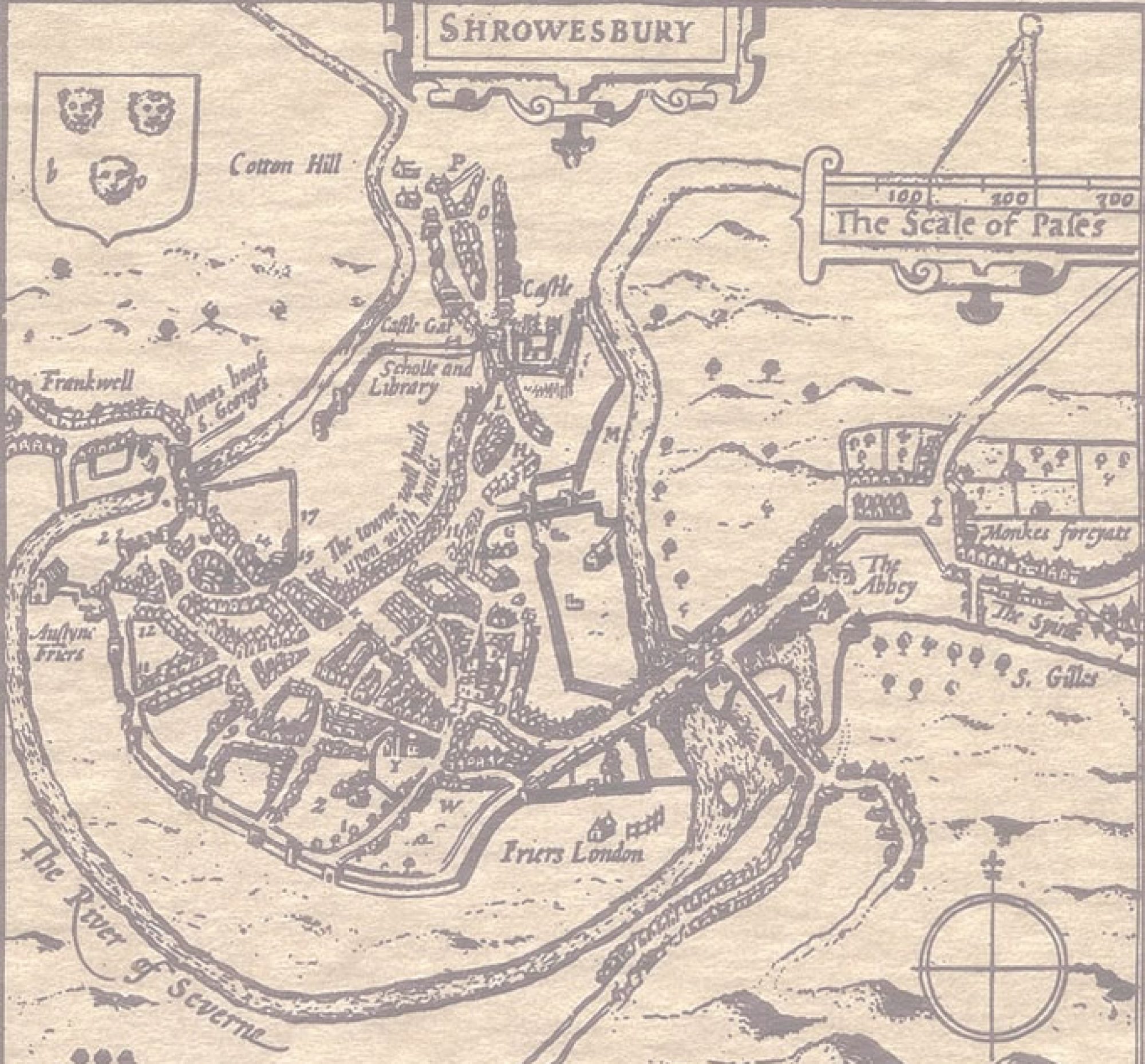Review of Bloody British History – Shrewsbury, by Dorothy Nicolle, History Press, 2013
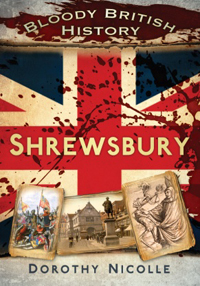 This book is an excellent example of popular Local History writing. Dorothy paints a picture of the history of Shrewsbury from the Roman conquest to the twentieth century, around the theme of shedding blood. This may be in local battles, such as the Battle of Shrewsbury or the Civil War. Or the conflicts may be further afield, like that of Rowland Hill in the Napoleonic wars, and the involvement of local people in the two World Wars. The ‘bloodshed’ may be more personal, relating the crime and punishment down the centuries. Some of the chapters, though, aren’t really ‘bloody’. An example would be ‘Thirty Things You Didn’t Know about Charles Darwin’, most of which are quite well known. Strangely, the fact that Darwin was addicted to shooting as a young man doesn’t get a mention.
This book is an excellent example of popular Local History writing. Dorothy paints a picture of the history of Shrewsbury from the Roman conquest to the twentieth century, around the theme of shedding blood. This may be in local battles, such as the Battle of Shrewsbury or the Civil War. Or the conflicts may be further afield, like that of Rowland Hill in the Napoleonic wars, and the involvement of local people in the two World Wars. The ‘bloodshed’ may be more personal, relating the crime and punishment down the centuries. Some of the chapters, though, aren’t really ‘bloody’. An example would be ‘Thirty Things You Didn’t Know about Charles Darwin’, most of which are quite well known. Strangely, the fact that Darwin was addicted to shooting as a young man doesn’t get a mention.
The breadth of Dorothy’s knowledge and research is impressive, though with the enormous amount of material to cover it is inevitable that she has more to say on some subjects than others. I particularly enjoyed the chapters on the Battle of Shrewsbury and Lord Hill, from which I learned a lot. The writing is excellent, moving along at a cracking pace, and there is an abundance of illustrations. There are also plenty of insets relating to the main subject of the chapter, and odd facts here and there. I understand that this is aimed at the popular end of the market, but I would have liked at least a brief bibliography to follow up some of the stories.
I hope this book encourages those who are unfamiliar with our town’s history to learn more. It is certainly one that I can recommend.
Review of Shrewsbury in the Great War, by Dorothy Nicolle, published by Pen and Sword
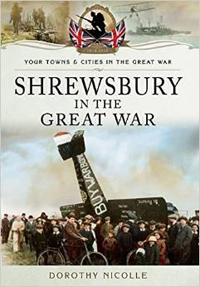 As with all Dorothy Nicolle’s books, this is a very enjoyable read. Before I read it I had very little idea what life was like for the ordinary resident of the town during the Great War. Dorothy successfully conjures this up by means of personal stories set against the backdrop of national and world events.
As with all Dorothy Nicolle’s books, this is a very enjoyable read. Before I read it I had very little idea what life was like for the ordinary resident of the town during the Great War. Dorothy successfully conjures this up by means of personal stories set against the backdrop of national and world events.
I had no idea that Shrewsbury had willingly hosted a significant number of Belgian refugees early in the war, nor that the significant reduction in licensing hours began during the war. It had also never occurred to me what an enormous challenge the voluntary hospitals faced to raise the money to cope with the avalanche of wounded soldiers. I was also surprised that Salopians bought £230,810 (perhaps £9 million at today’s prices) of War Bonds to help finance the war effort.
One of the great strengths of the book is the number and wide range of the illustrations. Dorothy is to be commended in sourcing many unusual and interesting images.
My only criticism of the book is that I would have liked the text to be referenced, but this is a popular, not an academic work. Otherwise I can thoroughly recommend this book.
Review of Shrewsbury at Work, by Nigel J Hinton, published by Amberley
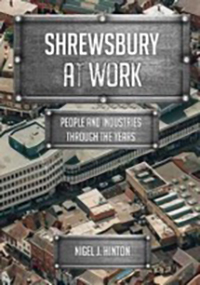 Shrewsbury is not noted as a manufacturing centre, but in fact there is a rich history to be mined of how people made their livelihoods in the town from mediaeval times onwards. Nigel Hinton has been doing this for a number of years, and the outcome is this informative and well-written book, full of illustrations, both historical and contemporary.
Shrewsbury is not noted as a manufacturing centre, but in fact there is a rich history to be mined of how people made their livelihoods in the town from mediaeval times onwards. Nigel Hinton has been doing this for a number of years, and the outcome is this informative and well-written book, full of illustrations, both historical and contemporary.
Starting with the mediaeval wool trade and its associated professions, Nigel describes some of the great figures of the Georgian and Victorian era, before considering life in the 20th century. Finally, he brings us up to date with many contemporary aspects of the town’s life.
Definitely a book I can recommend – very suitable for those who have any interest in local history.
Book Review of Lost Shrewsbury, by David Trumper, published by Amberley
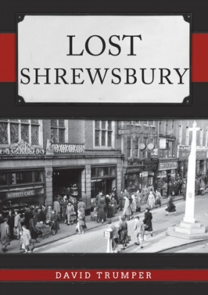 David Trumper is well known as a local historian with an unrivalled collection of old photographs of Shrewsbury, and is the author of many books. This time he has collected images, mostly from previously unpublished sources, of buildings that are no more (the chapter on floods seems a bit incongruous!). While there are published images of a good number of the buildings depicted, some I have never seen before. I was particularly interested in the Lead Works (p.64) which is a subject I have been seeking for a long time.
David Trumper is well known as a local historian with an unrivalled collection of old photographs of Shrewsbury, and is the author of many books. This time he has collected images, mostly from previously unpublished sources, of buildings that are no more (the chapter on floods seems a bit incongruous!). While there are published images of a good number of the buildings depicted, some I have never seen before. I was particularly interested in the Lead Works (p.64) which is a subject I have been seeking for a long time.
As with all of David’s books, the captions are detailed and informative, though a few of them (such as the Springfield Hotel, p.82 and The London Apprentice, p.85) lack location information. These captions are an excellent source for local information.
My only significant criticism is that there is no index, which makes looking for a specific location time-consuming. It would be really helpful if all the images of one street, say, could be detailed together in an index.
Apart from this, I can thoroughly recommend the book – ideal for a present!
